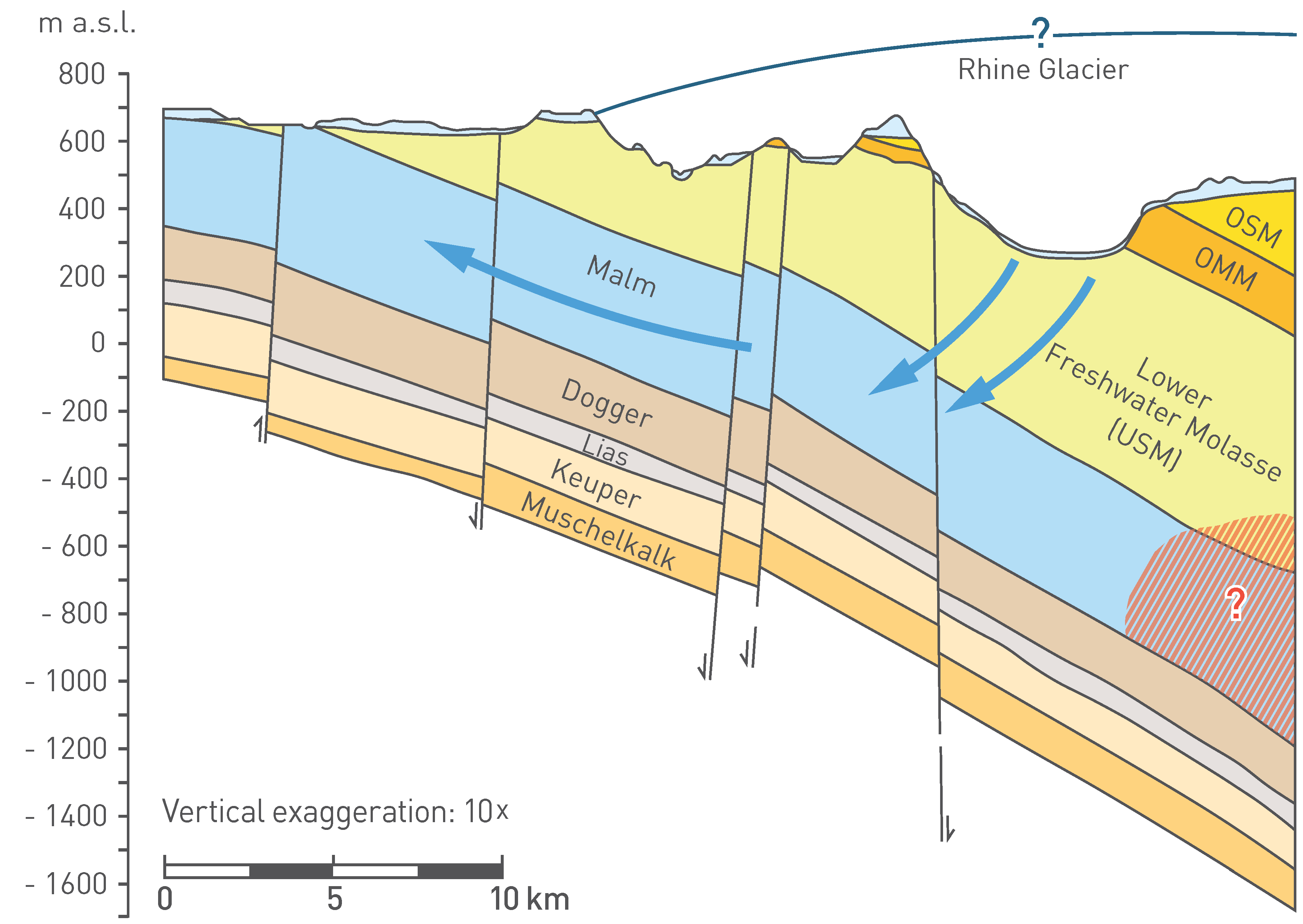During cold climate periods, the hydrogeological conditions may be affected by glaciation and permafrost (Section 6.3).
Water pressure below glaciers (warm-based, Section 6.3.2) increases with increasing ice thickness. A synthesis of studies in North America and Europe suggests that subglacial recharge may be increased by as much as 2 – 6 times compared to modern levels (Person et al. 2012). Such recharge may induce substantial changes in terms of water fluxes, hydraulic gradients, residence times and flow directions, as well as isotopic composition of the groundwaters. The depth to which this water infiltrates depends on numerous factors, such as the thickness of the ice, the duration of the glaciation and the hydraulic properties of the units below the glacier.
There is evidence from the study area of the effects of past glaciations on the hydrogeological system. In the Bodensee area, which was covered by substantial ice thicknesses in the past (Section 6.3.2), the groundwaters from the Malm and Molasse aquifers show a distinct cold climate isotopic signature, probably caused by increased subglacial recharge during the last glaciation period (Section 4.5.5.2, Fig. 6‑45). Note that today this area is considered to be a discharge area. In the Swiss Molasse Basin further to the south, water types change with increasing depth and include Molasse groundwaters that infiltrated during Pleistocene cold time periods (Waber & Traber 2022). In the siting regions, no evidence exists for such glaciation-induced cross-formation recharge processes into the Malm aquifer (Section 4.5.5.2). This may be because of lower ice thickness and shorter duration of glaciation (Fig. 6‑15), thick coverage by the Molasse sediments or differences in hydraulic conductivities of the Molasse and the Malm aquifer. Numerical simulations for a comparable geological setting in the Bavarian Molasse Basin show that a lower permeability aquifer below the Molasse cover may significantly reduce the depth of subglacial recharge (Schintgen & Moeck 2021). The fact that Malm permeabilities defined in these simulations compare well with the hydraulic conductivities measured in the siting regions of Northern Switzerland (Fig. 4‑88) indicates that the low permeability of the Malm aquifer minimises glaciation-induced cross-formation flow across the Molasse deposits into the Malm.
However, a reduction in overburden thickness and subsequent decompaction effects may lead to increased hydraulic conductivities in the Malm aquifer (Section 6.5.1.2), allowing for higher water fluxes and reduced residence times during future glaciations, in particular in the western part of ZNO. In JO, future glaciations are less likely (e.g. Sections 6.4.2.1 and 6.4.3) but could nevertheless affect the Hauptrogenstein aquifer.
In the past, Northern Switzerland was repeatedly affected by permafrost (Section 6.3). Permafrost may reduce or locally prevent recharge and/or discharge through freezing of pathways (e.g. Jost et al. 2007, McIntosh et al. 2012) and thus affect the flow systems mainly in terms of reducing water fluxes and increasing residence times. During the period under consideration, such changes are temporarily expected in all the siting regions.

Fig. 6‑45:Schematic representation showing Pleistocene subglacial meltwater recharge into the Malm aquifer in the Bodensee area
Figure from Waber & Traber (2022), based on earlier work of Bertleff & Watzel (2002). Blue arrows indicated recharge of subglacial meltwater into the Malm aquifer. Red hatched area indicates remnants of saline deep groundwaters. Note that there is no indication for such Pleistocene cross-formation meltwater flow across the Molasse in the siting regions. However, cross-formation flow across the Molasse and Malm could become more relevant in the future after reduction of the Malm overburden thickness (see text for discussion).

